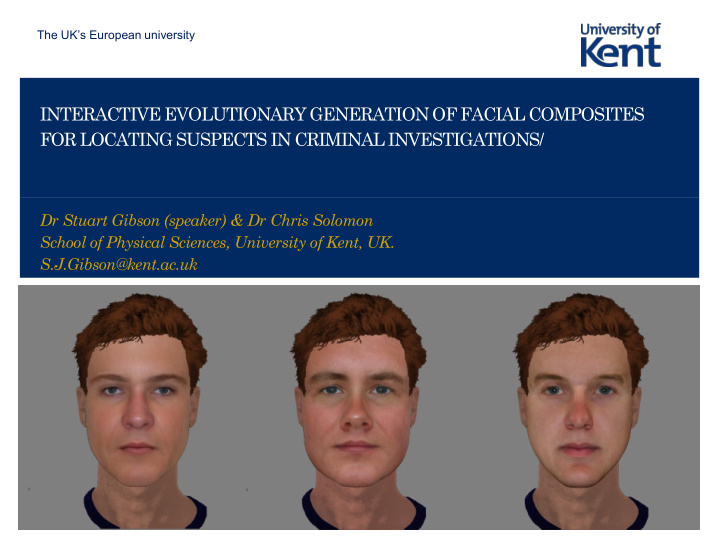



The UK’s European university INTERACTIVE EVOLUTIONARY GENERATION OF FACIAL COMPOSITES FOR LOCATING SUSPECTS IN CRIMINAL INVESTIGATIONS/ Dr Stuart Gibson (speaker) & Dr Chris Solomon School of Physical Sciences, University of Kent, UK. S.J.Gibson@kent.ac.uk
Background • Facial composite system: • Tool for creating a likeness to a suspect’s face based on an eyewitness’ description. • Used by the majority of police services in the UK and used in most other countries. • Sometimes only tool available to locate suspect. Page 2 Privacy Enhancing Technologies for Biometric Data 2016
Feature based systems • Likeness to suspect constructed by piecing together individual facial features. Page 3 Privacy Enhancing Technologies for Biometric Data 2016
Limitations of feature based systems • Humans are poor at • Feature based approach recall and description not well suited to global (but good at recognition ) transformations (e.g. • Psychological studies increasing perceived age) • Artistic skill required to show we recognise faces holistically not as a sum add enhancements. of individual facial features (Tanaka,1993). Page 4 Privacy Enhancing Technologies for Biometric Data 2016
Features vs whole • It’s impossible to discern any details in these facial features. • But recognition is still possible. Page 5 Privacy Enhancing Technologies for Biometric Data 2016
Time for a different approach • EFIT-V (EFIT6) is a holistic composite system – used by the majority of UK police and in many other countries. • Based on whole face recognition not feature recall. Page 6 Privacy Enhancing Technologies for Biometric Data 2016
Our method is ‘holistic’ (i.e. whole face) • Training sample of images – dimension reduction using principle component analysis (PCA). • Any face can be approximated by a vector of numbers (dimension << number of pixels). • Iterative search using evolutionary algorithm (Gibson, 2003). • Similar idea to DNA - Vector = genotype, face image = phenotype . Page 7 Privacy Enhancing Technologies for Biometric Data 2016
Our method is ‘holistic’ (i.e. whole face) Select Population Multiply Mutate Page 8 Privacy Enhancing Technologies for Biometric Data 2016
Face-space search • Alternatively, can consider the problem of creating a START likeness to the LIKENESS suspect as a multi- dimensional search problem . Simplistic search-space representation Page 9 Privacy Enhancing Technologies for Biometric Data 2016
EFIT6 Software demo Page 10 Privacy Enhancing Technologies for Biometric Data 2016
EFIT-V Upper bound on accuracy • Target • ‘Portrait’ composite image Page 11 Privacy Enhancing Technologies for Biometric Data 2016
EFIT-V Typical accuracy composites Page 12 Privacy Enhancing Technologies for Biometric Data 2016
Studies on EFIT-V composite images • Composite creating participants were found to 1.5x more likely to correctly identify a target face from a police line-up than control participants (Davis, 2014). • Morphs of 4 composites produced by different witnesses (between-witness morphs) were judged better likenesses and were more frequently named by participants who were familiar with the target faces than were morphs of 4 composites produced by a single witness (within-witness morphs) (Valentine, 2010). Page 13 Privacy Enhancing Technologies for Biometric Data 2016
Current & future work Page 14 Privacy Enhancing Technologies for Biometric Data 2016
Improving cyber security using realistic synthetic face generation • Collaborative project between University of Haifa and University of Kent (UK). • The work plan comprises a novel programme of research that questions the uniqueness of facial identity and investigates the use of computer generated face imagery in the area of cyber security. • Investigators • Rita Osadchy (Haifa) • Orr Dunkleman (Haifa) • Julio Hernandez-Castro (Kent) • Stuart Gibson (Kent) • Chris Solomon (Kent) Page 15 Privacy Enhancing Technologies for Biometric Data 2016
Privacy issues relating to individuals in the training set • Face model generates new instances of faces as linear combinations of training images. • What are the implications for individuals in the training set? • Aim to show that the face model entropy is sufficiently high to avoid legalistic issues and wrongful arrest. Page 16 Privacy Enhancing Technologies for Biometric Data 2016
Bibliography • Davis, Josh P., Stuart Gibson, and Chris Solomon. "The Positive Influence of Creating a Holistic Facial Composite on Video Line ‐ up Identification." Applied Cognitive Psychology 28, no. 5 (2014): 634-639. • Mist, Joseph J., Stuart J. Gibson, and Christopher J. Solomon. Comparing Evolutionary Operators, Search Spaces, and Evolutionary Algorithms in the Construction of Facial Composites. Informatica 39, no. 2 (2015) 135-145. • Solomon, Christopher J., Stuart J. Gibson, and Joseph J. Mist. "Interactive evolutionary generation of facial composites for locating suspects in criminal investigations." Applied Soft Computing 13, no. 7 (2013): 3298-3306. • Valentine, Tim, Josh P. Davis, Kate Thorner, Chris Solomon, and Stuart Gibson. "Evolving and combining facial composites: Between-witness and within-witness morphs compared." Journal of Experimental Psychology: Applied 16, no. 1 (2010): 72. • Gibson, Stuart J., Christopher J. Solomon, and Alvaro Pallares Bejarano. "Synthesis of Photographic Quality Facial Composites using Evolutionary Algorithms." In BMVC , pp. 1-10. 2003. • Tanaka, James W., and Martha J. Farah. "Parts and wholes in face recognition." The Quarterly journal of experimental psychology 46, no. 2 (1993): 225-245. Page 17 Privacy Enhancing Technologies for Biometric Data 2016
THE UK’S ACKNOWLEGEMENTS/ EUROPEAN UNIVERSITY • Engineering and Physical Research Council EPSRC Grant REF EP/M013375/1 • Israel Ministry of Science Technology and Space MOST • VisionMetric Ltd (developers and distributers of EFIT-V & EFIT6) • Contact: s.j.gibson@kent.ac.uk www.kent.ac.uk
Recommend
More recommend